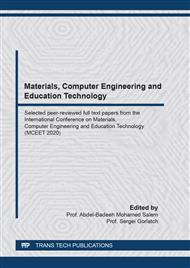[1]
Atiquzzaman M, Yen N, Xu Z, Big Data Analytics for Cyber-Physical System in Smart City, Berlin, (2020).
Google Scholar
[2]
Thippa RG , Praveen KRM , Lakshmanna K, et al. Analysis of Dimensionality Reduction Techniques on Big Data[J]. IEEE Access, 2020, PP(99):1-1.
Google Scholar
[3]
Deepa N., Pham Q.V., Nguyen D.C., Bhattacharya S., Gadekallu T.R., Maddikunta P.K.R., Fang F., Pathirana P.N., A Survey on Blockchain for Big Data: Approaches, Opportunities, and Future Directions,2020,arXiv preprint arXiv:2009.00858.
DOI: 10.1016/j.future.2022.01.017
Google Scholar
[4]
A.V. Bataev, Analysis of the Application of Big Data Technologies in the Financial Sphere," 2018 IEEE International Conference "Quality Management, Transport and Information Security, Information Technologies, (IT&QM&IS), St. Petersburg, 2018, pp.568-572.
DOI: 10.1109/itmqis.2018.8525121
Google Scholar
[5]
Han Young Joo, Jae Wook Kim, Joo Hyun Moon,Use of big data analysis to investigate the relationship between natural radiation dose rates and cancer incidences in Republic of Korea,Nuclear Engineering and Technology,Volume 52, Issue 8,2020,Pages 1798-1806.
DOI: 10.1016/j.net.2020.01.015
Google Scholar
[6]
Lingjun Song, Keyao Zhang, Tongyi Liang, Xuebing Han, Yingjie Zhang,Intelligent state of health estimation for lithium-ion battery pack based on big data analysis,Journal of Energy Storage,Volume 32,2020,101836.
DOI: 10.1016/j.est.2020.101836
Google Scholar
[7]
Nishita Mehta, Anil Pandit, Sharvari Shukla,Transforming healthcare with big data analytics and artificial intelligence: A systematic mapping study,Journal of Biomedical Informatics,Volume 100,2019,103311.
DOI: 10.1016/j.jbi.2019.103311
Google Scholar
[8]
Xiao Luo, Liang Dong, Yi Dou, Ning Zhang, Jingzheng Ren, Ye Li, Lu Sun, Shengyong Yao,Analysis on spatial-temporal features of taxis' emissions from big data informed travel patterns: a case of Shanghai, China,Journal of Cleaner Production,Volume 142, Part 2, 2017,Pages 926-935.
DOI: 10.1016/j.jclepro.2016.05.161
Google Scholar
[9]
J. Zhao and J. Guo, Big data analysis technology application in agricultural intelligence decision system,, 2018 IEEE 3rd International Conference on Cloud Computing and Big Data Analysis (ICCCBDA), Chengdu, 2018, pp.209-212.
DOI: 10.1109/icccbda.2018.8386513
Google Scholar
[10]
Y. Liu, Big Data Technology and Its Analysis of Application in Urban Intelligent Transportation System,, 2018 International Conference on Intelligent Transportation, Big Data & Smart City (ICITBS), Xiamen, 2018, pp.17-19.
DOI: 10.1109/icitbs.2018.00012
Google Scholar
[11]
Schmitz GL, Nogara PA, Natiéle Medina, et al. Cockroaches: an alternative model to teach enzymatic inhibition to undergraduate students[J].
Google Scholar
[12]
J. Cui, Y. Wang, S. Fan, Z. Wang and S. Xu, Discussion on Computer Education Mode of Engineering Course in Independent College,, 2008 The 9th International Conference for Young Computer Scientists, Hunan, 2008, pp.2391-2395.
DOI: 10.1109/icycs.2008.375
Google Scholar
[13]
J. Gu, J. Zhao and S. Zhang, Discussion on teaching reform of computer application fundamental course in Chinese Universities,, 2010 5th International Conference on Computer Science & Education, Hefei, 2010, pp.824-827.
DOI: 10.1109/iccse.2010.5593486
Google Scholar
[14]
C. Zhang, L. Yang and H. Wang, Practice teaching reform of the course visual basic programing based on capability orientation,, 2016 11th International Conference on Computer Science & Education (ICCSE), Nagoya, 2016, pp.899-902.
DOI: 10.1109/iccse.2016.7581701
Google Scholar
[15]
Shen Qing, Jiang Yunliang and Su Xiaoping, Exploration on practice teaching in computer major,, 2010 International Conference on Educational and Information Technology, Chongqing, 2010, pp. V1-416-V1-418.
DOI: 10.1109/iceit.2010.5607660
Google Scholar
[16]
M. Garduño-Aparicio, J. Rodríguez-Reséndiz, G. Macias-Bobadilla and S. Thenozhi, A Multidisciplinary Industrial Robot Approach for Teaching Mechatronics-Related Courses,, in IEEE Transactions on Education, vol. 61, no. 1, pp.55-62, Feb. (2018).
DOI: 10.1109/te.2017.2741446
Google Scholar
[17]
R. Precup, S. Preitl, M. Radac, E.M. Petriu, C. Dragos and J.K. Tar, Experiment-Based Teaching in Advanced Control Engineering,, in IEEE Transactions on Education, vol. 54, no. 3, pp.345-355, Aug. (2011).
DOI: 10.1109/te.2010.2058575
Google Scholar
[18]
D. d. M. Magnus, L.F.B. Carbonera, L.L. Pfitscher, F.A. Farret, D.P. Bernardon and A.A. Tavares, An Educational Laboratory Approach for Hybrid Project-Based Learning of Synchronous Machine Stability and Control: A Case Study,, in IEEE Transactions on Education, vol. 63, no. 1, pp.48-55, Feb. (2020).
DOI: 10.1109/te.2019.2956909
Google Scholar


